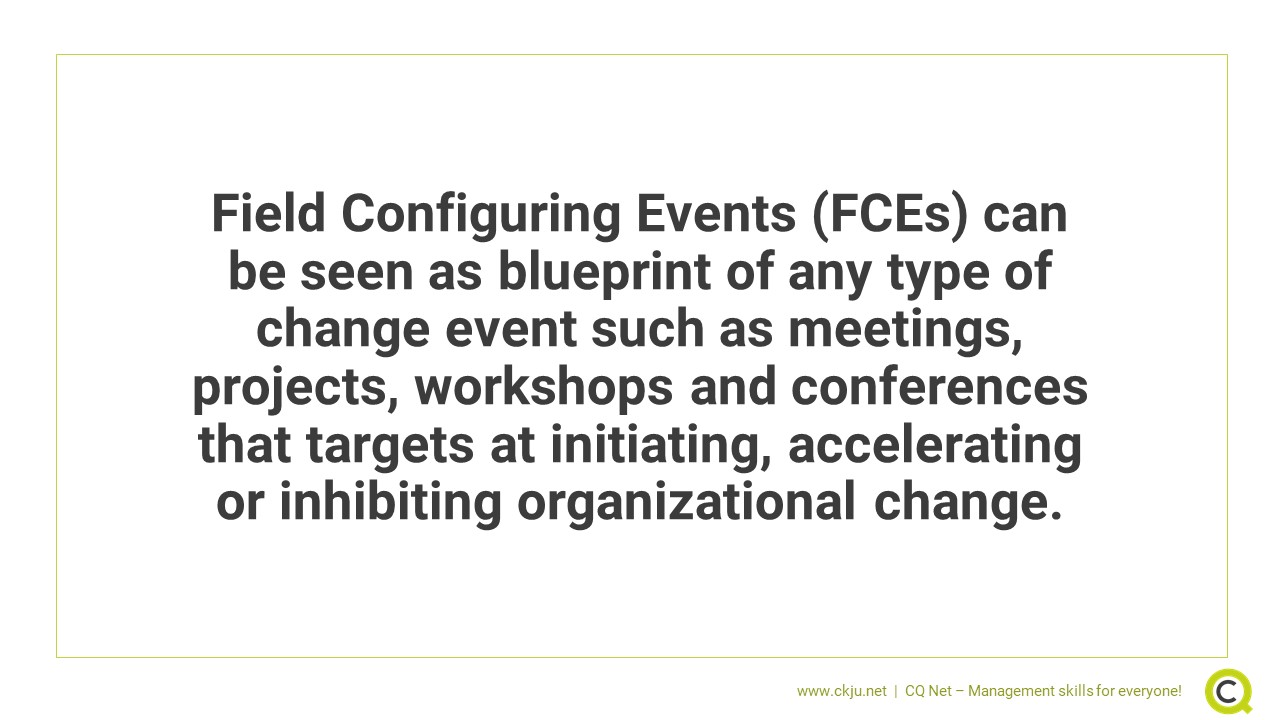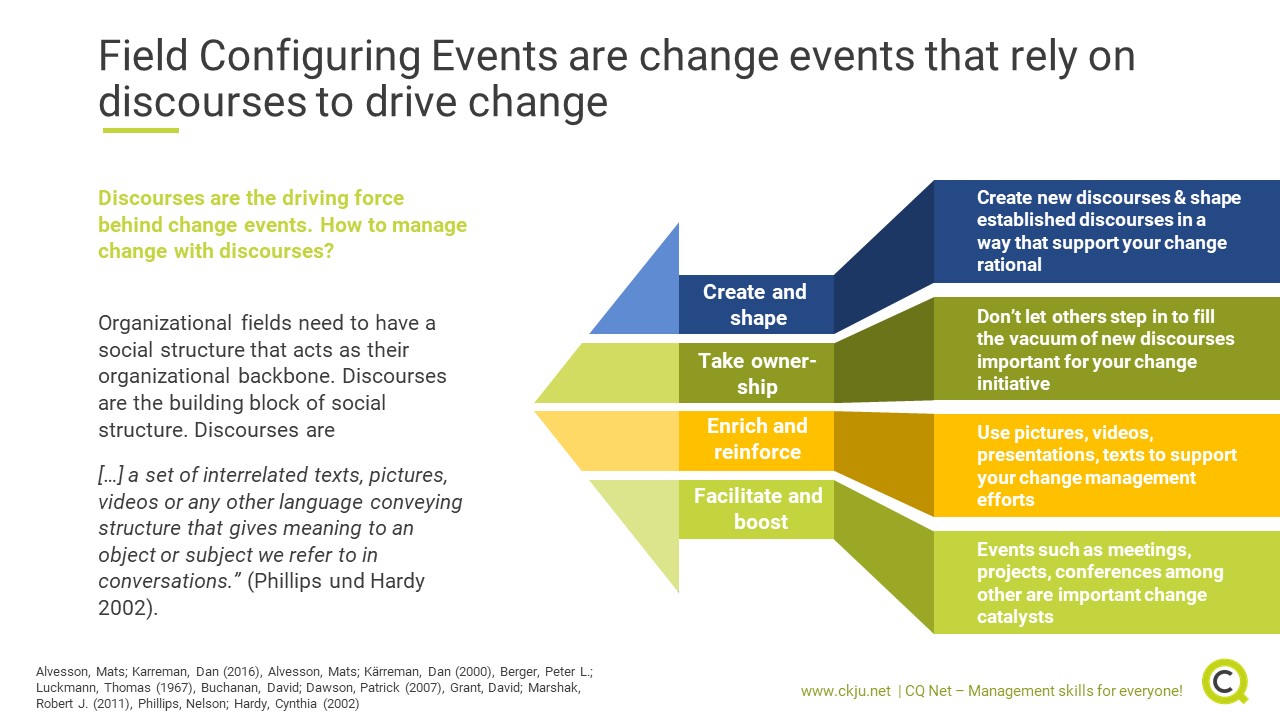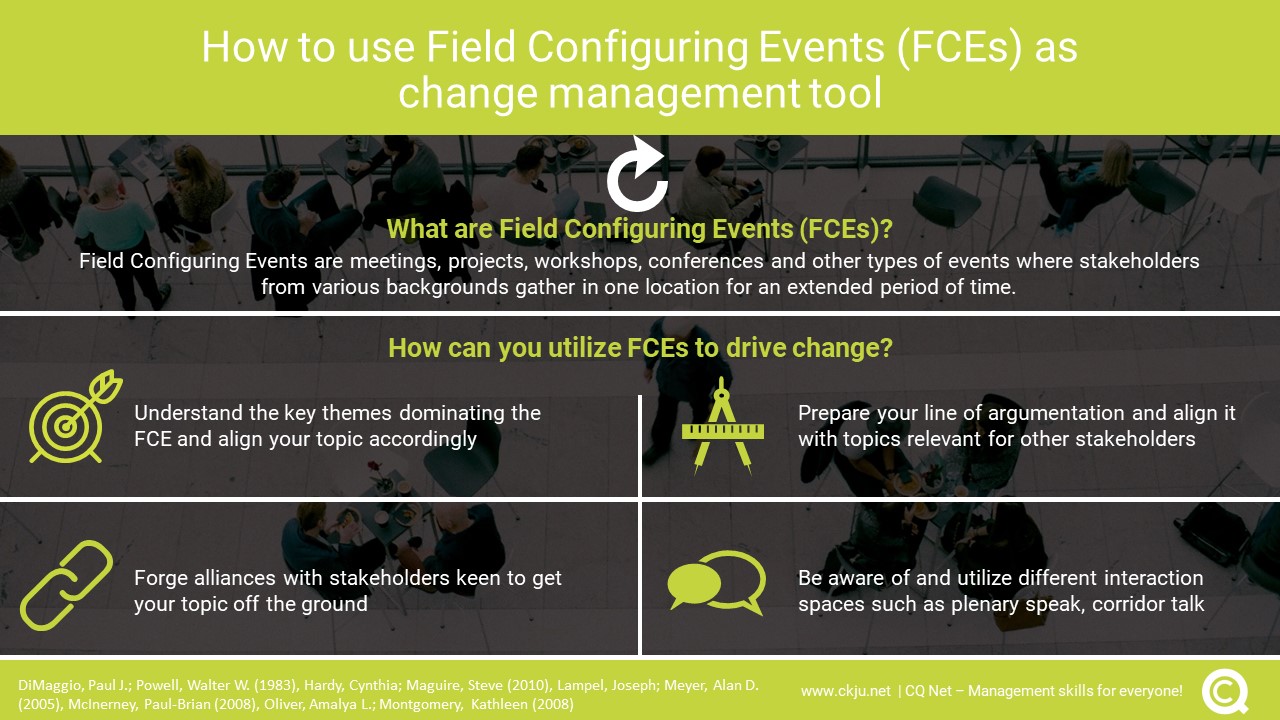- All Management Learning Resources
- field configuring events

Why should you care about Field Configuring Events (FCEs)?
Field Configuring Events is a new concept from organizational science that provides valuable insights into how change happens on a micro-level. It emphasizes the role of change events such as meetings, projects, workshop and conferences play in driving change. This makes Field Configuring Events a must know change management tool for professionals and managers alike. In this CQ Dossier we provide you all relevant information required to utilize Field Configuring Events as powerful change management tool.
Contents
- Why should you care about Field Configuring Events (FCEs)?
- What are Field Configuring Events?
- How do Field Configuring Events (FCEs) work?
- How to use FCEs as change management tool?
- FCEs offer an unique perspective about how change happens
- Critical appraisal of Field Configuring Events: Solidity Rating 2
- Key recommendations for professionals
- References and further reading
What are Field Configuring Events?
When you work in an organization (as most of us do) change is your constant companion. Almost any intervention you perform will or should initiative some sort of change. Think of starting a new product development project or of launching a product or service into a new market. Disruptive change has the power to move entire markets upside down in the blink of an eye.
The skills and tools required not just to cope with change but to initiate and guide it in a way such that you and your organization benefit of it are of critical importance. However, how does change happen? Which evidence-based change management tools are available that help you to manage change?
Field Configuring Events provide insights into how change happens
Field Configuring Events (Lampel and Meyer 2005) is a recent concept from organizational science that provides interesting insights into how change happens and how it can be managed. Even though there is not (yet) much empirical evidence available on Field Configuring Events, the concept is of value for professionals and managers alike. Why?
- First, Field Configuring Events emphasis the non-linear character of change which is contrast to most of the popular change management models arguing that change takes place in a controlled and linear manner (Meyer et al. 2005).
- Second, the concept offers a frame for a better understanding how events such as conferences, workshops, projects, trade fairs etc. can be utilized as change management tool.
- Third, Field Configuring Events shed light on which specific actions do initiate, drive or inhibit change.
Field Configuring Events can be seen as some sort of blueprint of any type of change event that targets initiating or accelerating change initiatives. Let's have a look at the theoretical foundation of the concept.
Field Configuring Events initiate, shape and disrupt organizational fields
The origin of Field Configuring Events goes back to the concept of organizational fields. Organizational fields “constitute a recognized area of institutional life” (DiMaggio and Powell 1983, p. 148) which can be everything from supply chain networks to technology clusters and business associations. Following this definition, organizational fields are less than the typical organization which all of us refer to as companies, governmental or non-governmental organizations.
However, organizational fields are more than the “background noise” or everything else besides the typical organization. They consist of different types of stakeholders (employees, suppliers, clients, influencers, regulators etc.) who are somehow connected to each other because of a common objective, interest or desire.
As a professional or manager you and your organization are most properly part of many different organizational fields. You are most properly also interested in changing, influencing or even initiating new organizational fields. Practical examples of such change management interventions are:
- You want to develop a new product for a new market you didn’t do business before. This would require you to create a new organizational field or disrupt one that is already in place.
- You want to improve the performance of your suppliers as part of a supply chain improvement initiative. This approach requires you to change an existing field by creating a major change momentum.
- You want to influence the regulatory framework (e.g. norms and standards) in your industry. This change management intervention is about influencing an established organizational field or creating a new one when there is no regulation in place yet.
How do Field Configuring Events (FCEs) work?
The very basis to utilize FCEs as change management tools is an understanding of how they work. In the following section we have a look at the most recent insights from science and research into the interplay of social structures, stakeholders and communication as key building blocks of FCEs.
FCE drive change by “configuring” the social structure of organizational fields
In order to exist, organizational fields need to have a social structure that acts as their organizational backbone. The term social structure refers in this context to symbols, signs, texts, narratives (also called discourses), formal and informal rules and even memory traces of individual stakeholders that characterizes an organizational field.
FCEs are a means to create, change and maintain such social structures. This makes them a powerful change management tool to initiate, shape or maintain organizational fields. What are the practical implications for managing organizational change?
FCE are change events
When stakeholders from various backgrounds gather in one location for an extended period of time (from hours to days) and discuss topics important to them in a formal and informal way, they question, change and initiate social structures (Lampel and Meyer 2005). Depending on the change momentum created by the FCE, this structuration process (DiMaggio and Powell 1983) has the potential to create now organizational fields and change or maintain existing ones.
More specifically, FCEs can be understood as change events. Such a change event can be a meeting, a conference or a traid fair. However, not every meeting, conference and trade fair is should be considered a change event. How does this happen?
How to use FCEs as change management tool?
Once it is clear how FCEs work, it is important to get a better understanding how they can be used to deliberately manage change. In the next section we will provide you a set of recommendation how to use FCE as change management tool.
Manage change by promoting the right topics, forging alliances and build bridges at FCEs
FCEs are arenas of collective sense-making. The (competing) topics raised and addressed during FCEs are the starting point of such a collective sense-making process. However, not every topic on the agenda of a meeting, conference or workshop creates enough change momentum to initiate or shape an organizational field.
What does the evidence tell us about specific actions that have an impact on whether a topic makes it on the change shortlist or not?
Oliver and Montgomery (2008) conducted a case study with a network analysis of an FCE of a professional lawyers association in Israel. The analysis revealed that from 13 topic categories addressed by 29 speakers from three regional committees only two topics led to a significant change of the professional field of Israeli lawyers (Oliver and Montgomery 2008). The regional committee which managed to transform the organizational field with their topics
- was the best prepared one in terms of having a common understanding of which topics are the most important ones to be addressed at the Field Configuring Event (preparation and focus),
- had two members who played a central role in the collective sense-making process since they addressed topics important for many other participants (facilitation and compatibility) and
- had one member who addressed topics that connected speakers who otherwise didn’t share a topic (building bridges and coalitions).
Be aware of and utilize different interaction spaces to create a change event
In another case study Hardy and Maguire (2010) come to the conclusion that FCEs offer different spaces for interaction. An interaction space (referred to as discursive spaces) can be a plenary speak, a corridor talk or external communication (Hardy and Maguire 2010) whereas each of those spaces has different participants, serves a different purpose and is regulated by different rules. Being aware of those spaces and their characteristics is the very basis to impact the direction the FCE drives change.
In a business setting an interaction space could be a project work-stream, a steering committee a change communication initiative among others. Being aware of those spaces and how they relate to each other is key to drive the change initiative in the right direction.
Understand the key theme and align it with stakeholder expectations
Two case studies (Hardy and Maguire 2010; McInerney 2008) support the claim that the change dynamic taking place at FCEs follows key themes (referred to as narratives). Those key themes reflect the state of the FCE and the change trajectory. In order to impact the direction the FCE drives change, it is key to
- Being aware of those themes,
- having a plan on how they should develop, and
- aligning arguments in a way such that they match stakeholders' expectations (McInerney 2008).
FCEs offer an unique perspective about how change happens
FCEs offer a unique perspective about how change takes place on a micro level. Even though the evidence available is still limited, there are first indications which interventions support you as a management practitioner to drive change in the desired direction. In addition,
FCEs support the claim that change is nothing that can be planned in a rigorous way but is a dynamic process which can be guided up to a certain extend. In conclusion, FCEs are an innovative change management tool which is still under development but can already be applied by management practitioners.
Critical appraisal of Field Configuring Events: Solidity Rating 2
There is not yet much evidence available that supports the concept of Field Configuring Events. However, first empirical studies and a strong link to systems theory, physics and sociology makes FCE an important change management tool. As a result, we assign the evidence supporting the concept a solidity rating of 2 on a 1-5 measurement scale. This doesn`t make the tool less important for managing change, but indicates that more studies are needed in order to support the claims made by empirical evidence.
Key recommendations for professionals
- Field Configuring Events drive change by configuring the social structure of organizational fields
- Field Configuring Events are meetings, projects, workshops, conferences
- Drive change by promoting important topics, forging alliances and build bridges at Field Configuring Events
- Be aware of and utilize different interaction spaces (plenary speak, corridor talk) Field Configuring Events offer
- Understand the key theme and the stakeholders expectations and how they evolve at Field Configuring Events
Management skills newsletter
Join our monthly newsletter to receive management tips, tricks and insights directly into your inbox!
References and further reading
DiMaggio, Paul J.; Powell, Walter W. (1983): The Iron Cage Revisited. Institutional Isomorphism and Collective Rationality in Organizational Fields. In American Sociological Review 48 (2), p. 147. DOI: 10.2307/2095101.
Hardy, Cynthia; Maguire, Steve (2010): Discourse, Field-Configuring Events, and Change in Organizations and Institutional Fields. Narratives of DDT and the Stockholm Convention. In AMJ 53 (6), pp. 1365–1392. DOI: 10.5465/amj.2010.57318384.
Lampel, Joseph; Meyer, Alan D. (2005): Field-Configuring Events as Structuring Mechanisms. How Conferences, Ceremonies, and Trade Shows Constitute New Technologies, Industries, and Markets. In Journal of Management Studies 42 (5), pp. 1099–1100. DOI: 10.1111/j.1467-6486.2005.00534.x.
McInerney, Paul-Brian (2008): Showdown at Kykuit. Field-Configuring Events as Loci for Conventionalizing Accounts. In Journal of Management Studies 45 (6), pp. 1089–1116. DOI: 10.1111/j.1467-6486.2008.00784.x
Meyer, Alan D.; Gaba, Vibha; Colwell, Kenneth A. (2005): Organizing Far from Equilibrium. Nonlinear Change in Organizational Fields. In Organization Science 16 (5), pp. 456–473. DOI: 10.1287/orsc.1050.0135
Oliver, Amalya L.; Montgomery, Kathleen (2008): Using Field-Configuring Events for Sense-Making. A Cognitive Network Approach. In Journal of Management Studies 45 (6), pp. 1147–1167. DOI: 10.1111/j.1467-6486.2008.00786.x.
About the Author









